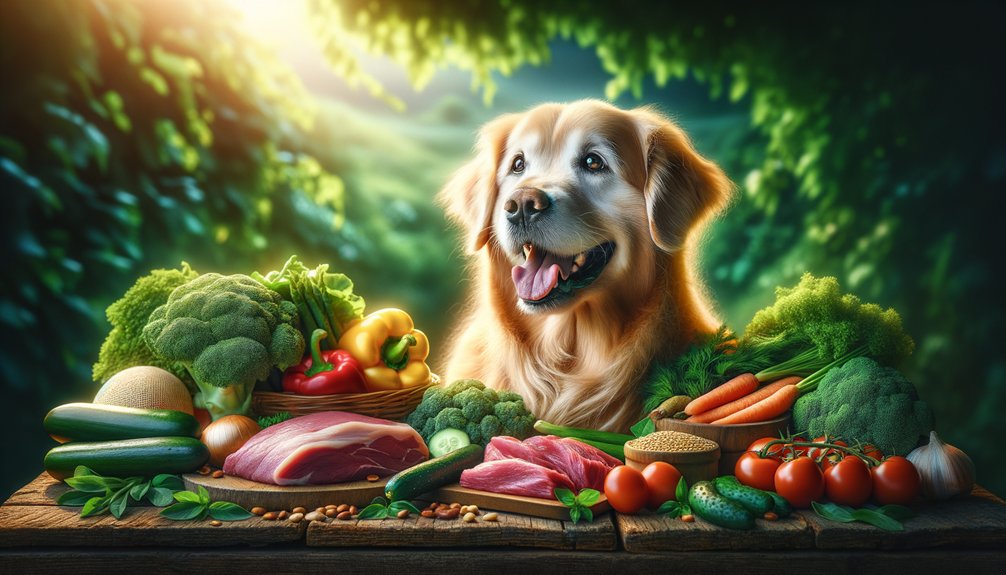AI-assisted
Last updated on June 23, 2025
Have you ever wondered what truly makes the perfect meal for your furry friend? In The Ultimate Dog Nutrition Guide, we dive deep into how the right food can transform your dog’s energy, immunity, and coat health. With so many options—grain-free formulas, hypoallergenic blends, and convenient subscriptions—it’s easy to feel lost. But don’t worry, choosing the best diet and switching foods safely doesn’t have to be complicated. Together, we’ll explore simple, effective steps to customize your dog’s nutrition, helping them thrive with every bite. Ready to unlock your dog’s full potential? Let’s get started!
Key Takeaways
- Good nutrition helps your dog stay healthy, full of energy, and live longer. Pick a diet that fits your dog’s breed and needs.
- Grain-free or hypoallergenic foods can cut allergies. They ease digestion and keep coat and skin in great shape.
- Switch foods slowly over 7–10 days to avoid tummy upset. Watch stool, mood, and energy as you make the change.
- Consider a dog food subscription for meals made just for your pup. It delivers the right portions and takes the guesswork out of feeding.
- Control portions, add daily exercise, and use low-calorie treats. This combo manages weight and boosts overall health.
Introduction

Feeding your dog the right food helps them stay healthy and live longer. Good meals give your dog energy, boost their immune system, and improve their well-being.
Learn the key nutrients your dog needs so you can choose the best diet.
Why optimal nutrition matters
Feeding your dog the right food keeps them healthy and well. It protects teeth and prevents dental issues. Good nutrition boosts energy and focus, making training easier and more fun. Knowing your dog’s breed history helps you pick diets that fit their unique needs.
Dog Food Subscription Services
Use a dog food subscription to make feeding easy and consistent.
You’ll get:
- Fresh, high-quality meals delivered
- Plans tailored to your dog’s age, size, and needs
- One less trip to the store
Look for a service that:
- Lists every ingredient clearly
- Lets you change meal size or schedule anytime
- Offers recipes your dog enjoys
Why Choose a Dog Food Subscription?
Choose a dog food subscription that fits your dog. It sends fresh, balanced meals to your door. You save time and feed your dog the same great food every day.
Define “best dog food subscription”
With a top dog food subscription, you get fresh, healthy meals made for your pet. They arrive at your door on time.
The best services fit your life and free you up for grooming, training, and puppy care. You pick a plan, see every ingredient, and count on steady delivery.
Your dog gets the food they need to grow and stay healthy—no hassle.
Top Benefits of Subscription Models
Choose a dog food subscription to get fresh, consistent meals delivered to your door. Enjoy custom meal plans made for your dog’s needs. Feeding is easy, and your dog gets balanced, high-quality nutrition.
Freshness & consistency
Because dog food subscription services deliver meals on a regular schedule, you can guarantee your pet always receives fresh, high-quality nutrition.
This consistency supports precise feeding schedules, enhances training routines, and fuels outdoor activities without interruption.
You’ll enjoy the freedom of knowing your dog’s diet remains reliable, promoting superior health and energy day after day with minimal effort on your part.
Custom meal plans
Although every dog has unique dietary needs, subscription services tailor meal plans to match your pet’s specific health requirements, preferences, and lifestyle.
They address nutritional deficiencies, support dental health, and complement exercise routines. These custom plans ensure peak well-being by:
- Balancing essential nutrients
- Promoting oral hygiene
- Adjusting portions based on activity levels
How to Pick the Best Subscription
How do you choose the best dog food subscription service among the many options available? Start by considering your dog’s breed selection and specific nutritional needs. Look for services that tailor meals like a pet store customizing chew toys—personalized and precise.
Guarantee the subscription offers high-quality ingredients and flexibility, so you control delivery frequency and portion sizes. Read reviews to gauge reliability and customer service.
A good subscription should simplify feeding without sacrificing quality or freedom. Prioritize transparency in sourcing and the ability to adjust plans as your dog grows or their preferences change.
Grain-Free Diet Benefits
You’ve probably noticed more grain-free dog foods on the market, and for good reason. Many pet owners report health improvements like better digestion and shinier coats when switching to grain-free diets.
Let’s separate the facts from the myths to help you decide if this option suits your dog’s needs.
The Rise of Grain-Free Dog Food
You’ll find grain-free dog food offers clear benefits, especially for pets with allergies or sensitive stomachs.
By removing common grains, these diets can reduce inflammation and improve digestion.
Understanding these advantages helps you make informed choices for your dog’s health.
Explain “grain free dog food benefits”
Although grains have long been a staple in many dog foods, grain-free options have gained popularity due to their potential benefits for dogs with sensitivities or allergies.
Choosing grain free dog food can improve your dog’s digestion and reduce inflammation.
Key benefits of grain free diets include:
- Enhanced nutrient absorption
- Reduced allergic reactions
- Better coat and skin health
Health Advantages
Choosing a grain-free diet can considerably reduce your dog’s allergic reactions by eliminating common irritants found in grains.
You’ll also notice improvements in their coat’s shine and overall digestion. These health benefits make grain-free options a valuable consideration for your dog’s nutrition plan.
Reduced allergies
Since many common allergens in dog food come from grains, switching to a grain-free diet can substantially reduce allergic reactions in your dog.
This supports holistic grooming and breed specific care by minimizing irritants.
Combine it with effective training techniques for overall well-being.
Benefits include:
- Decreased skin inflammation
- Reduced itching and discomfort
- Lower risk of chronic allergies
Improved coat & digestion
Reducing allergens in your dog’s diet not only eases skin irritation but also sets the stage for noticeable improvements in coat quality and digestive health.
You’ll see enhanced coat shine and better digestion health as nutrient absorption improves. A grain-free diet supports your dog’s freedom from discomfort, promoting vigor through optimized nutrient uptake and a healthier, glossier coat.
Myths vs. Facts
You might wonder if a grain-free diet is the best choice for your dog’s health. It’s important to separate common myths from facts before making a decision.
Understanding the real benefits and potential drawbacks will help you choose the right nutrition plan for your pet.
Is Grain-Free Right for Your Dog?
How do grain-free diets truly impact your dog’s health? The grain free controversy sparks debate among vets. Consider these factors before deciding:
- Vet opinions vary on grain-free benefits versus risks
- Ingredient sourcing affects nutrient balance and safety
- Some dogs may thrive without grains; others need them for energy
Weigh facts carefully to choose freedom in your dog’s nutrition.
Hypoallergenic Diets for Sensitive Dogs
If your dog shows itching, digestive upset, or chronic ear infections, they might have a food allergy.
Hypoallergenic diets eliminate common allergens like beef, dairy, and wheat to reduce reactions.
You’ll need to choose a formula that targets your dog’s specific sensitivities for the best results.
What Makes a Dog Food Hypoallergenic?
If your dog suffers from allergies, hypoallergenic dog food can help minimize adverse reactions by eliminating common allergens.
These diets use limited or novel protein sources and avoid ingredients that typically trigger sensitivities.
Understanding what makes a dog food hypoallergenic ensures you provide your pet with safe, balanced nutrition tailored to their needs.
Introduce “hypoallergenic dog food for allergies”
Because dogs with allergies need special care, choosing hypoallergenic dog food can make a significant difference in their health and comfort. This diet minimizes allergens, easing symptoms and promoting well-being.
Consider:
- Ingredients free from common allergens
- Support for skin health, aiding dog grooming
- Suitable for puppies post-adoption and during puppy training
Hypoallergenic food empowers your dog’s freedom from discomfort.
Common Allergens & Symptoms
Common foods can trigger your dog’s itch, tummy upset, or ear infections. Beef, dairy, wheat, and chicken often cause problems.
To help your dog feel better:
- Pick treats without these ingredients.
- Groom more often to calm sore skin.
- Reward good behavior with hypoallergenic snacks.
Avoiding these triggers gives your dog a happier, healthier life.
Choosing the Right Formula
Recognizing the allergens that affect your dog sets the foundation for selecting the right hypoallergenic formula. You want a diet that supports your dog’s health without compromising your freedom to enjoy dog park etiquette, puppy training, and leash safety.
Consider formulas with:
- Limited ingredients to minimize allergic reactions
- Novel proteins like duck or venison for sensitive systems
- Grain-free options if your dog shows intolerance
Choosing wisely guarantees your dog thrives without discomfort, letting you focus on training and socializing confidently.
Always consult your vet to tailor nutrition perfectly to your dog’s unique needs and lifestyle.
Safely Transitioning to New Food
When switching your dog’s food, follow a clear step-by-step plan to avoid digestive upset.
Start with small portions of the new food mixed with the old for days 1–3.
Then gradually increase the new food ratio through days 4–6.
Step-by-Step Transition Plan
When you switch your dog to new food, it’s vital to do so gradually to avoid digestive upset.
Start by mixing a small amount of the new food with the current diet, increasing the proportion over 7 to 10 days.
This careful approach helps your dog adjust smoothly and maintains their digestive health.
Anchor on “how to transition dog to new food safely”
Although switching your dog’s food might seem straightforward, doing it improperly can lead to digestive upset and nutrient imbalances. Shift gradually over 7–10 days by mixing old and new food.
Remember to:
- Monitor digestion and stool quality
- Maintain consistent feeding schedules
- Incorporate dog training and grooming tips for overall health
This careful approach supports your pet adoption journey and freedom in care.
Day 1–3: Small Portions
To avoid tummy troubles, introduce new food slowly. For the first three days, add just a small scoop of the new food to each meal. This gentle switch keeps your dog’s digestion calm and their energy high for training and grooming.
Watch your dog’s response closely. Tell your vet about any concerns at check-ups. A careful, slow change guards your dog’s health and fuels their active lifestyle.
Day 4–6: Increase New Food Ratio
After feeding small amounts of the new food, start adding more each day.
Over days 4 to 6, slowly change the mix. By day 6, most of each meal should be the new food.
Keep your dog’s grooming and training routine the same. This helps them adjust.
Watch for upset signs: tummy trouble or itching. If you worry, call your vet.
Pet insurance may cover diet advice—use it for extra peace of mind.
- Increase new food to about 50–75% of the meal
- Observe stool quality and energy levels
- Avoid sudden exercise changes during this period
Day 7+: Full Switch & Monitoring
Once your dog eats at least 75% new food, you can finish the switch. Watch for changes in appetite, energy, and stool quality. Good nutrients fuel digestion and vitality.
Pair the diet swap with daily training. This builds healthy eating habits and cuts stress.
Groom your dog often. A glossy coat shows solid nutrition.
Keep a simple journal of:
- Mood and energy
- Meal intake
- Stool quality
If your dog thrives, the switch worked. Stay alert to keep their new diet smooth and lasting.
Troubleshooting Upsets
If your dog has an upset stomach during the food switch, slow down. Give them extra time to adjust.
Watch closely. If they keep throwing up, have diarrhea, or stay tired after a few days, call your vet.
Act quickly to keep your dog healthy during the change.
When to slow down / consult vet
Most dogs adapt well to new food. If your dog keeps vomiting, has diarrhea, or seems tired, slow down the switch. Watch their feeding habits closely. Remember: exercise and age can affect digestion. If problems continue or get worse, call your vet. Quick action keeps your dog healthy and happy.
- Persistent vomiting or diarrhea
- Changes in energy or exercise tolerance
- Unusual feeding behavior or appetite loss
Calculating Dog Food Calories
Use our calorie calculator to feed your dog the right amount. Just enter their weight and activity level. Follow the portion size it gives you. Adjust the amounts if you want your dog to lose weight or stay the same.
Why You Need a Calorie Calculator
Use a dog calorie calculator to give your pet the right energy each day. It measures portions so you avoid overfeeding or underfeeding.
This tool keeps your dog healthy and at a good weight.
Frame importance of “dog food calorie calculator”
Use a dog calorie calculator to ensure your pet gets the right energy daily. It balances nutrition for better training, keeps your dog at a healthy weight, and prevents obesity-related health issues.
Use it to:
- Tailor portions precisely
- Monitor energy intake
- Adjust for activity levels
Interactive Calorie Calculator Embed
Feeding your dog the right amount of calories is easy. Just enter your dog’s weight, age, and activity level into our simple calculator. You’ll get a clear daily calorie target—whether your pup’s bounding through training or chilling after grooming. Pair these numbers with regular vet check-ups to keep nutrition on point. With this tool, you’ll take charge of your dog’s diet confidently and quickly.
Beyond calories, remember to:
- Keep fresh water available at all times.
- Rotate protein sources to prevent food sensitivities.
- Count treats in your daily total.
- Recalculate whenever your dog’s weight or routine changes.
- Consider omega-3 supplements for skin and coat health.
Next up: tailoring meal textures for dental health, adjusting macronutrients by life stage, or building a weekly meal planner that balances home-cooked and commercial diets.
Adjusting Portions for Goals
Adjusting your dog’s food helps them hit health or weight goals.
- Calculate your dog’s daily calories from its activity level.
- Set a feeding schedule that matches those calories.
Remember that treats add extra calories. Keep treat counts low so they don’t tip the balance.
Finally, pair tight portion control with regular exercise. This combo balances energy use and keeps your dog healthy and happy.
Consider these key points:
- Monitor and modify portions according to weight changes and activity shifts
- Choose low-calorie treat alternatives to avoid exceeding calorie limits
- Align feeding times with exercise to optimize metabolism and energy use
Conclusion
Feeding your dog may seem as easy as grabbing a bag off the shelf. But each bite has its own science. With the right food, calorie control, and a slow changeover, you’re doing more than giving a pet a meal. You’re fueling a healthy, happy life. Next time you reach for the “convenient” option, remember: easiest isn’t always best. Make smart choices—your dog will thank you with every wag.



